National Parks Half the Park Is After Dark Poster Art Series


Gordon Parks, Self-Portrait, 1941, gelatin silver impress, 50.viii × 40.64 cm (xx × xvi in.), Individual Drove. Courtesy of and copyright The Gordon Parks Foundation
How does Gordon Parks utilise photography to address inequities in the Usa?
How exercise Gordon Parks's images capture the intersections of art, race, class, and politics across the U.s.a.?
What do photographs in general—and Gordon Parks's photographs more specifically—tell us about the American Dream?
"A photographer can be a storyteller. Images of feel captured on film, when put together similar words, tin weave tales of feeling and emotion as assuming as literature.… [Photographers] bring together fact and fiction, experience, imagination, and feelings in a visual dialogue that has enormous bear on on how we observe and relate to the external world and our internal selves." —Philip Brookman, "Unlocked Doors: Gordon Parks at the Crossroads," Gordon Parks: Half Past Autumn, 1997
What did you picture while reading this quote? Consider where you meet photographs and images in your own life. What impact do they have on y'all?
In that location is perhaps no individual who embodies the power of photography more than than Gordon Parks. Photographer, poet, musician, storyteller, activist—Gordon Parks shaped the times in which he lived as much equally he was shaped by them. Though his career as a photographer spanned six decades, it is the period from 1940 to 1950, the focus of the exhibition Gordon Parks: The New Tide, Early Work 1940–1950, that about significantly defined his signal of view equally an African American artist and documenter of American life at the dawn of the modern civil rights motility.
In 1937, while working as a waiter on the Due north Declension Limited rider railroad train, Parks saw magazines featuring Low-era photographs—images like Dorothea Lange's
During the first decade of his career, Parks, a self-taught photographer, captured the beauty, power, and stature of Chicago socialite Marva Louis; the spirituality of churchgoers in Washington, DC; and portraits of prominent African Americans like
The photographs in this paradigm set speak to the power of Parks's voice as an creative person. His images certainly serve equally documents of specific moments in time; merely individually and as a group they too reveal humanity, implore empathy, pose questions, provoke outrage, and even inspire activism. Though taken decades ago, Parks's photographs capture individuals and represent issues and themes that even so resonate deeply with us today.
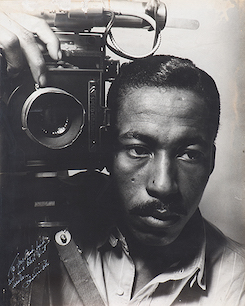
Gordon Parks Photography Gordon Parks, Self-Portrait, 1941, gelatin silver impress, 50.eight × 40.64 cm (xx × 16 in.), Individual Collection. Courtesy of and copyright The Gordon Parks Foundation The youngest of xv children, Gordon Parks was born in 1912 (d. 2006) in Fort Scott, Kansas. His parents had moved there from Tennessee in the years following the post–Ceremonious War Reconstruction period. Although he was shut with his supportive family, Parks could not ignore the inequality and racism around him. He recalls, "The indignities came so often that I presently began to accept them as normal. But I always fought back." Parks purchased his showtime camera in 1937 and committed himself to becoming a lensman. A consummate observer of the world, he found inspiration in magazines, museums, and books. He began experimenting with portraiture and some of his photographs were featured in the local African American newspaper in Saint Paul, Minnesota. Though primarily self-taught, Parks's education was influenced by other artists and mentors he encountered in the early part of his career. He would go on to achieve extraordinary success in his field, a major achievement for an African American lensman during the 1940s. In addition to photographing for Life, Ebony, and Faddy, Parks was a poet, author, musician, and filmmaker. Parks was but 28 years old when he took this self-portrait. He carefully composed it to demonstrate his close connection with his vocation: his face is aligned with the lens of his photographic camera (one typical of those used by press photographers at the time) and his expression is quite contemplative.
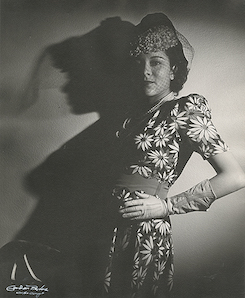
Gordon Parks Photography Gordon Parks, Marva Trotter Louis, Chicago, Illinois, 1941, gelatin silverish print, epitome: 24.13 × xx cm (9 one/two × 7 7/8 in.), sheet: 25.4 × 20.64 cm (10 × 8 1/viii in.), The Gordon Parks Foundation, GP04581. Courtesy of and copyright The Gordon Parks Foundation Early in his career, Parks found success as a fashion and portrait photographer. Marva Trotter Louis, socialite, fashion designer, and wife of famous heavyweight boxing champion Joe Louis, was an early supporter of Parks. She was i of many people who encouraged him to move to Chicago in the early 1940s. Here, Parks demonstrates the power of fashion, pose, gaze, and lighting as tools to both convey the personality of the subject as well as make a captivating epitome. What do you detect outset about Marva Trotter Louis? Observe her clothing: floral wearing apparel, long gloves, chapeau, and veil. Expect at her pose: relaxed, turned body; hand on hip; and a gaze which directly meets our own optics. What do these elements say about her? Dramatic lighting casts only i side of her body in light; a nighttime shadow in profile dominates the left side of the image. Why might Parks have arranged his composition this way? Discuss how this image either challenges or reinforces your notions virtually race, gender, class, and power. How might this portrait have been perceived in 1941, the year it was taken?
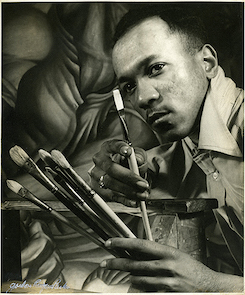
Gordon Parks Photography Gordon Parks, Charles White in front of his mural "Chaos of the American Negro," 1941, gelatin silver impress, epitome: 24 × xix.8 cm (9 i/2 × 7 thirteen/xvi in.), framed: 25.3 × 20.2 cm (9 15/16 × 7 15/16 in.), Charles White Archives. Courtesy of and copyright The Gordon Parks Foundation Parks moved to Chicago in 1941 and became affiliated with the S Side Community Art Center, where he had a studio and darkroom. He developed relationships with a number of artists living and working in Chicago, including Charles White. White encouraged Parks, who was primarily shooting portraits, to have his camera into the streets and certificate the poverty he found there. With his own tools in hand, White is featured in forepart of his mural, Chaos of the American Negro. What strategies does Parks utilise in his limerick to communicate his respect for this creative person? Compare this portrait with Parks's Cocky-Portrait besides taken in 1941 (Slide 1). What similarities and differences do you find? Learn more than about Charles White
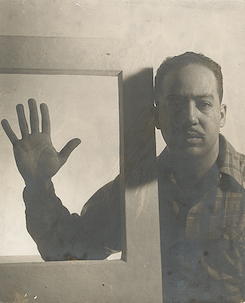
Gordon Parks Photography Gordon Parks,Langston Hughes, Chicago, December 1941, gelatin silverish print, printed later on, Corcoran Collection (The Gordon Parks Collection), 2016.117.102 Equally a leader of the Harlem Renaissance, Langston Hughes addressed important racial issues of the mean solar day through his poetry, essays, and plays. His piece of work inspired many African American artists, including Gordon Parks. Parks had moved to Chicago in 1941, and through his piece of work with the Southward Side Community Fine art Center had further adult the psychological content of his portraits. The frame-inside-a-frame composition of this portrait strikes a playful note, counterbalanced by Hughes'due south sober, contemplative expression. Is this a portrait of Hughes or his hand? Physically separated from the rest of his body by the frame, his hand and arm take on a special prominence in the photograph, suggesting Hughes's ability equally a writer. Parks took this photograph just a couple of weeks after the Japanese set on on Pearl Harbor, which brought the United States into World War Two.
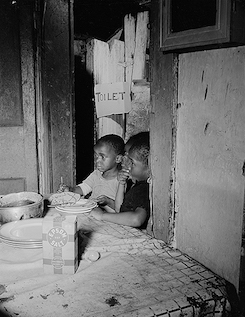
Gordon Parks Photography Gordon Parks, Washington, D.C. Iii children waiting in the kitchen while their mother prepares the evening meal. June 1942, gelatin silver print, sheet: 23.7 × 18.vii cm (9 v/sixteen × 7 three/8 in.), mountain: 29 × 24 cm (11 7/sixteen × 9 seven/sixteen in.), Prints and Photographs Sectionalisation, Library of Congress, Washington, D.C. This is ane of many photographs that Parks fabricated in Washington while working for the Farm Security Administration (FSA), a regime agency. Roy Stryker, the head of the FSA'southward Historical Section, encouraged Parks to look closely at photographs by other bureau photographers before beginning his own work. The subject and carefully arranged limerick of this photo demonstrate the influence of that enquiry. Parks uses strong lighting to illuminate a night, dingy interior with 3 young children sitting underneath a handwritten sign indicating the bathroom backside them. In the foreground is a box of Epsom salt, perhaps a nod to the daily manual labor performed by the unseen adults in the house. The photo is documentary in nature, just also highly manipulated and evocative. Parks included captions with his photographs meant to provide background information. The caption states that the 3 subjects are waiting for their mother to prepare dinner. How does this boosted information assistance you read the image? If you lot could give this photograph a title (instead of a caption), what would information technology exist?
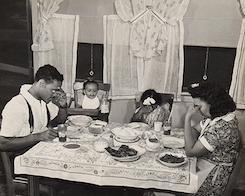
Gordon Parks Photography Gordon Parks, Anacostia, D.C. Frederick Douglass Housing Project. A family says grace before the evening meal. June 1942, gelatin silver print, image: 19.iii × 24 cm (7 5/viii × 9 7/16 in.), canvas: 20.6 × 25.2 cm (8 1/8 × 9 fifteen/sixteen in.), The Museum of Fine Arts, Houston, Museum purchase funded by Mrs. Clare A. Glassell In 1941 and 1942, under the auspices of the Federal Public Housing Authority and the Alley Dwelling Authority (later on renamed the National Capital Housing Say-so), new public housing, such equally the Frederick Douglass Dwellings in the Anacostia neighborhood of Washington, DC, was erected for black defense force workers. At this time housing, theaters, restaurants, and many shops in the nation'south capital were segregated. Parks was assigned to cover life in the housing projection. What can we learn about this family from looking at this photograph? Why might the government have assigned a photographer to document life at this housing project? Consider that this picture was taken just months after the assail on Pearl Harbor on December vii, 1941, when the American government was actively preparing for war. Blackness Americans sought means to support the war effort by enlisting in the military or working in defense industries, just often faced discrimination in their attempts to practice so. Regime-produced images such as this one offered hope for the future by demonstrating that life was getting better for African Americans, an idealistic representation of the lived experience at the time.
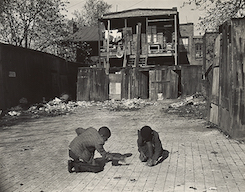
Gordon Parks Photography Gordon Parks, Washington (southwest section), D.C. Two Negro boys shooting marbles in front of their dwelling. November 1942, gelatin silverish print, image: 9.2 × 11.7 cm (3 five/eight × 4 v/viii in.), sheet: 10 × 12.four cm (3 15/16 × 4 7/8 in.), The Museum of Fine Arts, Houston, Museum buy funded by the Mundy Companies. Courtesy of and copyright The Gordon Parks Foundation In the foreground of this photograph, ii young boys are engaged in play. The caption indicates that the run-down construction in the alley behind them, surrounded by trash and urban squalor, is their abode. The boys, then immersed in their game, seem unaware of their environment as well as the photographer capturing this moment. What does this photograph tell y'all virtually the living conditions in Washington, DC, in 1942? What details in the photograph support your conclusions? Imagine you are a government official seeing this photograph for the first time. Does it inspire you lot to take activeness? Why or why non? Back up your thinking with details from the photograph.
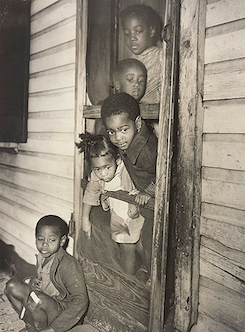
Gordon Parks Photography Gordon Parks, Washington (southwest section), D.C. Negro children in the front door of their home. Nov 1942, gelatin silver print, 33.66 × 24.77 cm (thirteen 1/4 × 9 3/4 in.), Photographs and Prints Division, Schomburg Centre for Enquiry in Blackness Civilization, The New York Public Library, Astor, Lenox and Tilden Foundations What has brought these five children to the front end door of their home? Why has Parks chosen to photo them in detail? Parks gives u.s. footling visual information to answer those questions. Instead, he offers united states a moment to contemplate each of these children individually. What must their lives be like? What practice their expressions and crowded organization by the door tell us virtually their connections as family? Parks had a item sensitivity to capturing the spirit, hope, and humanity of young people in urban and rural settings.

Gordon Parks Photography Gordon Parks, Washington, D.C. Authorities charwoman cleaning after regular working hours. July 1942, gelatin silver print, 35.56 × 27.94 cm (14 × eleven in.), Photographs and Prints Partitioning, Schomburg Center for Research in Black Civilisation, The New York Public Library, Astor, Lenox and Tilden Foundations Equally i of Parks'southward first assignments for the Farm Security Administration (FSA), he interviewed Ella Watson, who was cleaning offices at the Department of Agronomics, where the FSA was housed. He learned of her story of hardship and with her permission photographed her non only at work, but at home, with her family, and in her community. Information technology was from this serial of approximately 85 images that Parks produced one his well-nigh iconic works, Washington, D.C. Government charwoman (American Gothic). The additional photographs in the serial offering a multilayered presentation of Ella Watson's life. Many of the images reflect the oppression and hardship she, like Parks, experienced in Washington, DC, just they as well show moments of spirituality, beloved, and hope. In this photograph, Parks shows Ella Watson solitary, cleaning one of the many government offices. The harsh light focused on one bespeak on the flooring casts Watson into the shadows of the room, hinting at the invisibility of her work. Consider the function of light in this photograph and compare it to Parks'due south portrait of Marva Trotter Louis. What can we learn near Ella Watson's professional and personal life from this photograph? Learn more about Washington, D.C. Government charwoman (American Gothic)
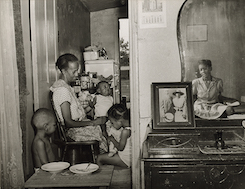
Gordon Parks Photography Gordon Parks,Washington, D.C. Mrs. Ella Watson, a government charwoman, with 3 grandchildren and her adopted daugther, July 1942, gelatin silver impress, printed later, Corcoran Collection (The Gordon Parks Collection), 2016.117.106 As 1 of Parks's offset assignments for the Farm Security Administration (FSA), he interviewed Ella Watson, who was cleaning offices at the Section of Agriculture, where the FSA was housed. He learned of her story of hardship and with her permission photographed her not simply at work, but at home, with her family, and in her community. It was from this series of approximately 85 images that Parks produced i his about iconic works, Washington, D.C. Government charwoman (American Gothic). The additional photographs in the series offering a multilayered presentation of Ella Watson's life. Many of the images reflect the oppression and hardship she, like Parks, experienced in Washington, DC, but they also show moments of spirituality, dearest, and hope. This is an paradigm of Watson at dwelling house with her family. We glimpse her adopted daughter, Loretta, in the reflection of the mirror (on the right), seemingly contemplating the photograph of Watson's parents, also visible to us. Watson is surrounded by her grandchildren in the kitchen, possibly enjoying some time together after dinner. Four generations are included in this photograph, demonstrating the importance of Watson's extended family. What can nosotros learn about Ella Watson's professional person and personal life from this photograph? Learn more about Washington, D.C. Authorities charwoman (American Gothic)
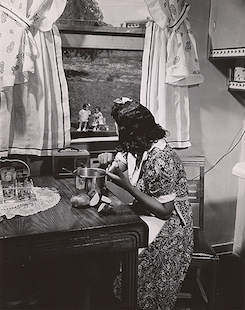
Gordon Parks Photography Gordon Parks, Anacostia, D.C. Frederick Douglass housing project. Mother watching her children equally she prepares the evening meal. June 1942, gelatin silverish print, 25.iv × 20.three cm (10 × 8 in.), Photography Collection, Miriam and Ira D. Wallach Sectionalization of Art, Prints and Photographs, The New York Public Library, Astor, Lenox and Tilden Foundations. Courtesy of and copyright The Gordon Parks Foundation Compare this photo with the one of Ella Watson similarly sitting by an open window, both taken by Parks in 1942 in Washington, DC. What details do you notice that assist to tell each adult female'due south story? Why do you call back he has us looking at the backs of their heads? Practise you consider these works to be portraits? Why or why not? What is Parks possibly communicating near race and gender in 1940s America?
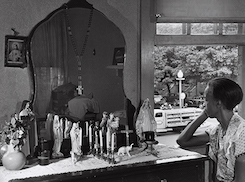
Gordon Parks Photography Gordon Parks,Washington, D.C., Mrs. Ella Watson, a Regime Charwoman, July 1942, gelatin silver print, printed 1960s, Gift of Julia J. Norrell, 2015.119.one Compare this photograph with the one of a mother in the Frederick Douglass housing project similarly sitting by an open window, both taken by Parks in 1942 in Washington, DC. What details do you notice that assistance to tell each woman's story? Why do you think he has us looking at the backs of their heads? Practice yous consider these works to exist portraits? Why or why not? What is Parks possibly communicating well-nigh race and gender in 1940s America?
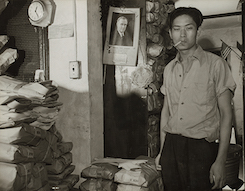
Gordon Parks Photography Gordon Parks, Washington, D.C. Johnnie Lew, owner of the laundry under the apartment of Mrs. Ella Watson, a government charwoman, August 1942, gelatin silver print, canvas: xviii.two × 23.3 cm (vii three/16 × 9 three/16 in.), mount: 24.1 × 29 cm (9 1/2 × 11 7/16 in.), Prints and Photographs Sectionalization, Library of Congress, Washington, D.C. Every bit the caption indicates, Parks took this photograph as part of his work documenting Ella Watson'due south life. This photograph offers a glimpse of the diverseness of people who contributed to life and labor in and around Washington, DC. It is impossible to ignore that the discipline, Johnnie Lew, is flanked by a picture show of 32nd President Franklin Delano Roosevelt (over his right shoulder) and an American flag (which waves above his left shoulder). How does this image contribute to the story of labor in the United States?
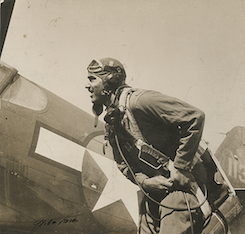
Gordon Parks Photography Gordon Parks, Lt. George Knox. 332nd Fighter Group preparation at Selfridge Field, Michigan, October 1943, gelatin silver impress mounted on board with explanation, image: 25.4 × 26.35 cm (10 × 10 iii/viii in.), sheet: 27.31 × 26.35 cm (10 three/4 × 10 iii/8 in.), The Gordon Parks Foundation, GP02596. Courtesy of and copyright The Gordon Parks Foundation In 1943, the increasingly unpopular Farm Security Administration (FSA) was abolished, pieces of which were and then absorbed into the Function of War Information (OWI). Earlier the FSA closed though, Parks was selected to transfer to the OWI, which he did in October 1942. He was assigned as a war correspondent to encompass the 332nd Fighter Grouping, the starting time regiment of black pilots, who were training about Detroit, Michigan. Parks'southward attempts to travel with the pilots for their first deployment away were continually thwarted by officials in the federal regime, some of whom were not supportive of black pilots receiving such publicity.
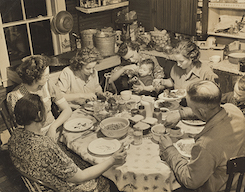
Gordon Parks Photography Gordon Parks,Dinner Time at Mr. Hercules Brown's Home, Somerville, Maine, Feb 1944, gelatin silver impress, printed subsequently, Corcoran Collection (The Gordon Parks Collection), 2016.117.128 Gordon Parks took this photograph while on assignment for the Standard Oil Company (New Jersey), a corporation suffering a massive public relations crisis related to a prophylactic shortage that threatened the country's ability to fight in World War Ii. Part of Parks's consignment was to represent how the oil manufacture positively impacted life in the Us. Parks spent eight days with the Brown family, pictured here sharing a family unit meal. Look closely at who is gathered effectually the table. Hercules Chocolate-brown sits with his wife, 3 daughters, and grandson. His son-in-police is abroad fighting in the state of war. What can you learn about this family based on what you see in the photo? Detect how we, as the viewer, seem to exist looking downwards at the tabular array. Where do you recall Parks was when he took this moving picture? Compare with this image with Anacostia, D.C. Frederick Douglass Housing Projection.
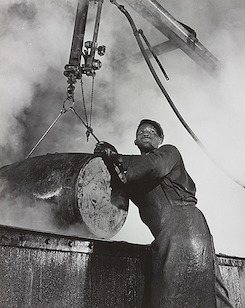
Gordon Parks Photography Gordon Parks, Pittsburgh, Pa. The cooper'due south establish at the Penola, Inc. grease plant, where large drums and containers are reconditioned. March 1944, gelatin silvery impress, canvas: 23.9 × nineteen.ane cm (nine 7/sixteen × 7 one/ii in.), mount: 29 × 24 cm (xi vii/16 × ix 7/16 in.), Prints and Photographs Sectionalization, Library of Congress, Washington, D.C. Courtesy of and copyright The Gordon Parks Foundation Employed by Penola, Inc., this bearding African American worker toils to clean grease barrels by dipping them in boiling lye. The but human presence in a landscape of steam and steel, Parks uses dramatic lighting and a depression angle to present him equally a hero of industry. Understanding that his efforts were ane part of an intricate system to supply essential lubricants to the military fighting overseas elevates him to the status of American hero, perhaps. Parks wrote to Roy Stryker from Pittsburgh: "Photographing the grease found at Pittsburgh was a pretty nasty job. Information technology was nasty because in every building and on every floor grease was underfoot. The interiors in the older buildings were extremely nighttime and absorbed enough of lite, then it was necessary to use long extensions and many bulbs. The extensions throughout the day were covered with grease….I might add that a day at the grease plant leaves i with an enormous ambition." Is this an image of American progress? Why or why not?
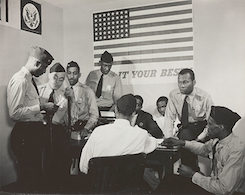
Gordon Parks Photography Gordon Parks, Washington, D.C. Auxiliary police at a weekly meeting, July 1942, gelatin silvery impress, xx.32 × 25.4 cm (8 × 10 in.), Photographs and Prints Sectionalisation, Schomburg Eye for Enquiry in Black Culture, The New York Public Library, Astor, Lenox and Tilden Foundations In 1942, Washington, DC, was all the same a segregated city. This meant that civilian defense activities, such every bit this group of auxiliary constabulary (reserves who could exist called up in an emergency), were also segregated. Serious, uniformed men gather around their instructor confronting the backdrop of a big American flag and the motto "Give It YOUR All-time." We have every reason to believe they are doing just that. This posed photograph fabricated a case for the kind of patriotism that included efforts by all Americans, regardless of race, to aid the country fight and win World State of war Ii.
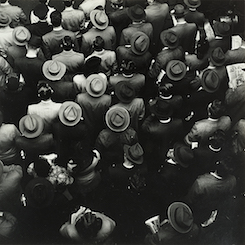
Gordon Parks Photography Gordon Parks,Ferry gunkhole from Staten Island to Manhattan, carrying early morning commuters, New York City, November 1946, gelatin silver print, printed later, Corcoran Drove (The Gordon Parks Collection), 2016.117.129 Given its reliance on oil and lubricants, transportation was an important theme for the documentary photographers at Standard Oil Company (New Jersey). New York Harbor, where crowds of commuters made their way to Manhattan on the Staten Island Ferry, represented the epicenter of this idea. Consider the perspective in this photograph: Where is the photographer standing to have this picture? What does this photograph tell us most the nature of work in the U.s.? Who is nowadays? Who is missing?

Gordon Parks Photography Gordon Parks, Untitled, Harlem, New York, 1947, gelatin silver print, prototype: 17.78 × 17.46 cm (7 × 6 7/8 in.), sail: 20.32 × 18.42 cm (eight × seven 1/4 in.), The Gordon Parks Foundation, GP04135. Courtesy of and copyright The Gordon Parks Foundation Here, Parks tackles problems of race in a visibly bold way, reminiscent of his work Washington, D.C. Government charwoman (American Gothic). Parks took this motion picture on assignment for Ebony magazine in 1947 for an article called, "Problem Kids: New Harlem clinic rescues ghetto youth from emotional brusk excursion." The article featured the work of psychiatrists Mamie and Kenneth Clark, whose "doll test" enquiry investigated issues of segregation and cocky-esteem in blackness children. African American children in segregated schools were shown a blackness doll and a white doll and then asked to choose one. The majority picked the white doll, indicating that segregation impacted the children's feelings of self-worth. Their research, while non wholly scientific, was used in school desegregation lawsuits including Dark-brown v. Board of Education (1954). Imagine you are the editor of Ebony mag. Would y'all have chosen to include this paradigm in your story? Why or why not?
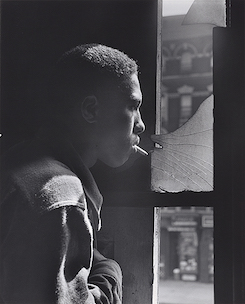
Gordon Parks Photography Gordon Parks,Trapped in abandoned edifice by a rival gang on street, Cherry Jackson ponders his next move, 1948, gelatin argent print, Corcoran Drove (The Gordon Parks Collection), 2015.xix.4605 On assignment for Life mag, Parks followed Leonard "Red" Jackson, a 17-year-onetime Harlem gang leader. Parks'southward photo essay captured the violence and fear experienced by gang members and their families, and positioned him as an important documentary photographer. A year afterward, Parks would become the first African American to be named staff photographer at Life. Forty years later, Parks ran into Ruddy Jackson, who suggested, "You lot know, you and me could go back up to Harlem together and save some of those kids up there. I'm always request myself about how I got into and so much trouble" (Gordon Parks, Half By Fall: A Retrospective [Boston, 1999], 84). This photo does non directly depict the danger associated with gang violence. Jackson does not confront the camera, notwithstanding the photograph offers close, virtually intimate, admission to the subject field. It invites united states of america to consider what he might be thinking, seeing, or feeling. What role might these photographs play in a larger essay on gang violence? Do they offer hope? Describe how the setting, details, and lighting in each photograph inform your stance.
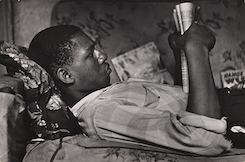
Gordon Parks Photography Gordon Parks, Red's Younger Blood brother at Home, Harlem, 1948, gelatin silver print, image: 22.1 × 33.4 cm (viii xi/16 × 13 one/eight in.), framed: 40.64 × 50.8 cm (sixteen × 20 in.), The Cleveland Museum of Fine art, Norman O. Stone and Ella A. Stone Memorial Fund, 2002.70 On assignment for Life mag, Parks followed Leonard "Red" Jackson, a 17-year-one-time Harlem gang leader. Parks's photo essay captured the violence and fear experienced by gang members and their families, and positioned him every bit an important documentary photographer. A year subsequently, Parks would become the showtime African American to be named staff photographer at Life. Forty years afterwards, Parks ran into Red Jackson, who suggested, "You know, you lot and me could go back up to Harlem together and relieve some of those kids up there. I'm always request myself about how I got into so much trouble" (Gordon Parks, Half Past Fall: A Retrospective [Boston, 1999], 84). This photo does not directly depict the danger associated with gang violence. Red Jackson'due south brother does non face the camera, yet the photograph offers close, nigh intimate, access to the field of study. Information technology invites united states to consider what he might exist thinking, seeing, or feeling. What role might these photographs play in a larger essay on gang violence? Practise they offering hope? Draw how the setting, details, and lighting in each photograph inform your stance.
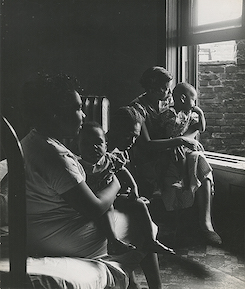
Gordon Parks Photography Gordon Parks, Tenement Dwellers, Chicago, 1950, gelatin silver print, 32.7 × 27.62 cm (12 7/8 × 10 7/viii in.), The Gordon Parks Foundation, GP04541. Courtesy of and copyright The Gordon Parks Foundation In 1950, Life assigned Parks to produce a story about school segregation, then an increasingly important consequence in the nation's discourse on civil rights. Parks chose to return to his hometown of Fort Scott, Kansas, to find out what had become of his classmates from the segregated Plaza School. Part documentary, part nostalgia, this trip offered Parks a chance to reverberate on how his understanding of a place changed with time and how segregation affected the lives of his classmates and friends. Compare the 2 photographs of Parks's former classmates. They concluded up in unlike cities, Chicago and Detroit respectively. What else is different about their life paths? How might they each correspond the furnishings of segregation? Imagine yous had the opportunity to return to your hometown 30 years from now. What might you expect to run across? What would you lot photograph?
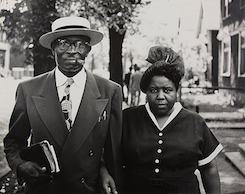
Gordon Parks Photography Gordon Parks, Husband and Wife on Sunday Morning, Detroit, Michigan, 1950, gelatin silverish impress, forty.01 × 49.85 cm (15 3/4 × 19 5/8 in.), The Gordon Parks Foundation, GP06161. Courtesy of and copyright The Gordon Parks Foundation In 1950, Life assigned Parks to produce a story about school segregation, then an increasingly important upshot in the nation'due south soapbox on civil rights. Parks chose to return to his hometown of Fort Scott, Kansas, to discover out what had become of his classmates from the segregated Plaza School. Function documentary, role nostalgia, this trip offered Parks a gamble to reflect on how his understanding of a identify changed with time and how segregation afflicted the lives of his classmates and friends. Compare the ii photographs of Parks'due south former classmates. They ended up in different cities, Chicago and Detroit respectively. What else is different almost their life paths? How might they each represent the effects of segregation? Imagine yous had the opportunity to return to your hometown 30 years from at present. What might y'all await to come across? What would y'all photograph?
Source: https://www.nga.gov/learn/teachers/lessons-activities/uncovering-america/parks-photography.html
0 Response to "National Parks Half the Park Is After Dark Poster Art Series"
Post a Comment